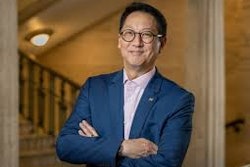Tested Practices Buoy University of Phoenix Online
Black Issues presents in Techtalk the first of occasional question-and-
answer sessions with prominent information technology leaders in higher education. In this issue, Brian Mueller, vice president and chief operating officer of the profitable University of Phoenix Online, discusses the for-profit higher education company’s track record at running one of the nation’s largest academic degree-granting online programs.
The company’s roots go back to 1989, when it was launched to take teaching and learning practices pioneered by its campus-based affiliate entity, the University of Phoenix, to the online world. Of the 110,000 students currently enrolled in University of Phoenix programs, nearly 37,000 are pursuing degrees in more than two dozen undergraduate and graduate online programs.
BI: Why has the University of Phoenix been able to experience consistent growth in its online education programs?
BM: We have a number of advantages. One, we were designing our program back in 1989, and we called it an online program, but the Internet wasn’t nearly as big as it is today. And so it was more of an off-line program as students would connect to our bank of servers to do their work. They would connect, and upload and download messages and assignments, and those kinds of things.
My point is that before the Internet really exploded, we were doing the experimenting necessary to figure out what the right model was. And so we went through that period of time where we lost money on (the online program), and we were willing to do that for the purpose of figuring out where we needed to be. By 1992, 1993 and 1994, we had developed the learning model that we knew would be successful in an online environment, so that when the Internet really started to explode we were in a perfect position to really be able to take advantage of that. People could take advantage of our programming, depending on which way you want to look at it.
A lot of other people were trying to react to the potential of distance education after the Internet explosion took place, trying to get into it fairly quickly and who had not thought through and developed a model that was workable and that met student needs. And, I think that, as much as anything, has been a reason for our success.
BI: What are the distinguishing features of your online programs?
BM: One, we would continue to teach working adult students in a small group environment. We’ve been teaching students with a specific learning model at the University of Phoenix since 1976. A big part of the model is to teach students in very small groups. On our campuses, we average about 15 students in a class. Online, we average between 10 and 11, but we don’t ever let it go over 13. So the small group environment is number one.
Number two, it’s a completely instructor-led process. The instructor is as much an integral part in the process in an online environment as the instructor is in a classroom environment. A lot of institutions try to take the instructor’s role and try to reduce it, and let media drive more of the learning. We never took that approach.
Thirdly, we wanted to create an academic environment that was very, very interactive, where students had a lot of contact with each other and a lot of contact with the faculty member. What we decided was the best way to approach that was to create an asynchronous classroom where students were required to log on five out of seven days every single week. And (we) take attendance, and you must be there. Students, literally, are going to be talking to each other in (online) discussions about that week’s work five out of seven days as a requirement. Most of them are in there seven out of seven days. They also have access to their instructor in a private in-box to submit assignments and ask any specific questions as they go through the week. Literally, they have access to their instructor 24 hours a day, seven days a week in an asynchronous fashion, and, for the most part, are getting responded to from that faculty member within hours of their asking a question or submitting work. So, lots of interaction, lots of collaboration. Almost a social kind of environment as much as an academic environment has been a huge reason for our success.
BI: Are there other features of your programs that might distinguish you from others?
BM: Students take only one class at a time. Each class lasts five weeks; up to six weeks as a graduate class. So students have the ability to focus only on one subject matter area before they move to the next one. The technology is simple. It is efficient, but it’s simple. And students are fine if they can connect up to 28.8 (kilobytes per second), and they don’t need higher speed connectivity than that to be successful.
We supply the students with a very organized approach to student services so all of the academic counseling and the financial advice that they need are provided by a team of people that are assigned specifically to them. That student service is really important because working adults don’t have the opportunity to try to work through those details themselves.
Probably, another big distinguishing feature is that we require 10 weeks of training for our faculty members before we ever put them into a classroom. Now, that’s an expensive proposition on our part, but we don’t want to take 10 or 11 students and put them with an inexperienced online instructor. That is a major distinguishing characteristic, which we think is a big part of our success.
BI: How has the online program benefited from the infrastructure and track record of the campus program?
BM: We’re kind of the classic example of a bricks-and-clicks organization. The fact we’ve been out there with a successful learning model for working adult students in a brick-and-mortar environment absolutely set the stage for us. It helped set the stage for us to be successful in an online environment. The universities that are trying to go at it with an online offering only, I think that it’s a little more difficult proposition. I think it’s been tremendously helpful to us that we were able to build on that brick-and-mortar campus success first.
BI: Why have a number of other online education programs failed?
BM: I think there has to be a very institutionalized, organized strategy around how to deliver education online. A lot of universities have let individual professors choose which platform they’re going to use, how they’re going to teach, how they expect students to learn, how much interaction there needs to be, how much communication between students there needs to be, and what is the optimal class size. (And) when you’ve got individual people making those judgments based upon little or no experience, you get a wide variety of experiences out there for students and the word spreads quickly if students are not satisfied.
We took a very institutional approach to it. We decided what we wanted the model to be, and we converted the curriculum to that model. We decided what we wanted the optimal class size to be; we decided what we were going to invest in terms of technical infrastructure, in terms of faculty training, in terms of student service support. All of these were decided from an institutional perspective, and so the strategy that eventually emerged and was successful was one that had been well thought out.
A lot of people have tried to get into it very quickly. They see it as a way to create a cash cow environment to support their brick-and-mortar business. They’ve gone at it from a large group size perspective. They haven’t institutionalized the faculty training component of it, or the platform part of it. And that can be a tough go because students form impressions quickly, and if I’m in this online environment in my first class and things are a bit confusing or the technology doesn’t work and there’s no technical support and the faculty member is a little bit lost, I form an opinion very quickly of whether it’s good and I pass that word on.
BI: Do you have plans to increase the number of degree programs? If so, in what fields?
BM: Yes, we do. Some of the ones that are coming out in the very near future are criminal justice at the bachelor’s level, software engineering at the bachelor’s level, and a teacher education program for elementary and secondary school teachers.
Criminal justice is going to be rolled out March 1; software engineering, May 1; and the teacher education program, March 1.
BI: Describe the challenge of recruiting and hiring instructors to maintain small class sizes?
BM: It’s definitely a challenge, but it’s absolutely essential to the success of the program. We have a fairly large academic affairs department with over 150 people in it when you include all of the faculty recruiters, the faculty trainers, and instructional specialists who are quality control people. When you include all of that infrastructure, it’s a significant number of people. We have a very organized approach to lead generations of faculty members, for selection of faculty members, for training of faculty members, and we want to keep the student to faculty ratio at about 10 to 1.
So right now, we have between 36,000 and 37,000 students, and we have about 3,500 faculty members.
BI: How have you fared with enrollment growth?
BM: It was slow at first, but we have grown 80 percent per year for the last two years. We are on track to do about 80 percent this year as well. We’ll probably finish this year with about 50,000 students, meaning at the end of August.
© Copyright 2005 by DiverseEducation.com


















